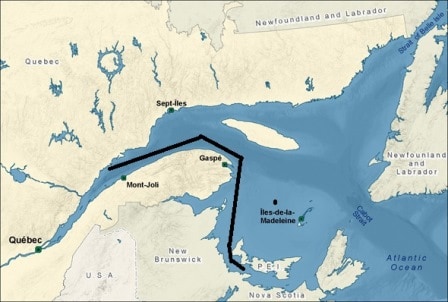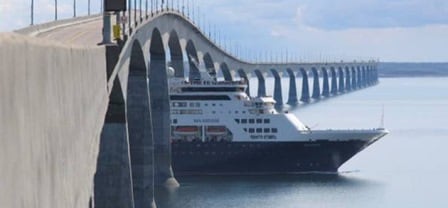Today we are sailing in the estuary / open sea area between where the St. Lawrence really begins and where you have the real open ocean. On departure yesterday it was blowing up to 45 knots and it did not change much during the night and morning. This morning I still observed a wind force 7 to 8 blowing out there. But as we are still in the estuary area, there is not much swell buildup and the ship is riding the waves in a nice and quiet way. Today is our only Sea day and thus it is a good thing that the ship is nice and quiet without any movements as otherwise it would upset all the regular proceedings including the Mariner Party, Mariner Medal presentation and Mariner luncheon. Not to mention happy hour later this afternoon. Another good thing is that we do not have to call today at Gaspe or at Sept. Isle which are two ports and we have them sometimes on the cruise schedule as well.
We cannot sail up and down the river anymore as we could in the good old days. Then we just gave the pilot an ETA (Estimated Time of Arrival) made sure the agent had a berth reserved for us and there we went. I already mentioned the Vessel Traffic Reporting on the river which is an Aid to Navigation as it helps to keep the ships apart. (There is also a similar system for when we sail under the Confederation Bridge to ensure we do not get any problems with ships blocking each other’s passage in the route to and under the bridge)

The Route from Quebec to Charlottetown and the part we sailed today. If we can not go under the Bridge then we have to sail past the island on the northside and then double back. (Courtesy: Canadian Fisheries)
But nowadays we also have a compulsory reporting system otherwise we are not even allowed to enter Canada, let alone sail up and down the river. Similar to USA regulations we have to provide 96 hours in advance a complete manifest of everybody on board and send it to the dedicated Canadian Customs Office. If we cannot do that because we have only a night or so between ports then the report has to be send the moment we leave. When we then cross the border and there is Canadian Coast Guard coverage, they check if indeed we have forwarded the manifest, before we are giving permission to enter coastal waters. For the Alaska cruises, sailing from Vancouver to Ketchikan and back this is standard practice. There is a Canadian Coastguard Station in Prince Rupert and we call them as soon as we cross the border. Canada has an enormous border and thus it cannot be expected that every inch of the country is monitored by the Authorities. If there is no direct Coast guard control possible then the port agent is the contact point and if we do not submit on time, then he/she is advised (sometimes friendly, sometimes not so friendly) that we have to get our act together. The ships are quite good in complying it is sometimes the internet that lets us down. I do not know how effective it is to check a ships manifest 96 hours in advance but I have heard about Customs and Immigration waiting at the gangway to arrest people with outstanding warrants, outstanding fines or having another question mark behind their name.
Around 4 am. tomorrow morning we will pass again under the Confederation Bridge, unless it is too windy, so that is something the Captain will continue to monitor today. That decision has nothing to do with the bridge but with the narrow fairway that you sail through to get under it. The pilot likes to sail under it with a sedate speed and if the wind is then on the beam, you get a lot of drift and for drifting the channel is too small. If this would occur, then we have to sail around Prince Edward Island and that costs extra time. We can then still arrive on time but the decision has to be made timely. I am not expecting that to happen as the wind is supposed to die down to about 10 knots, with even less in the port, but the weather does not always follow the weather forecast.
I am hoping for calm weather as tomorrow my lifeboat and tender driver students are starting the practical part of their training. And although they must be fully proficient in boat handling in bad weather as well, I need to start them off in nice weather as otherwise they will be too nervous.
So if the weather gurus are right, it will be: Partly cloudy skies and 16o C / 61 oF. with 6 knots of wind. That I can live with.


Leave a Reply